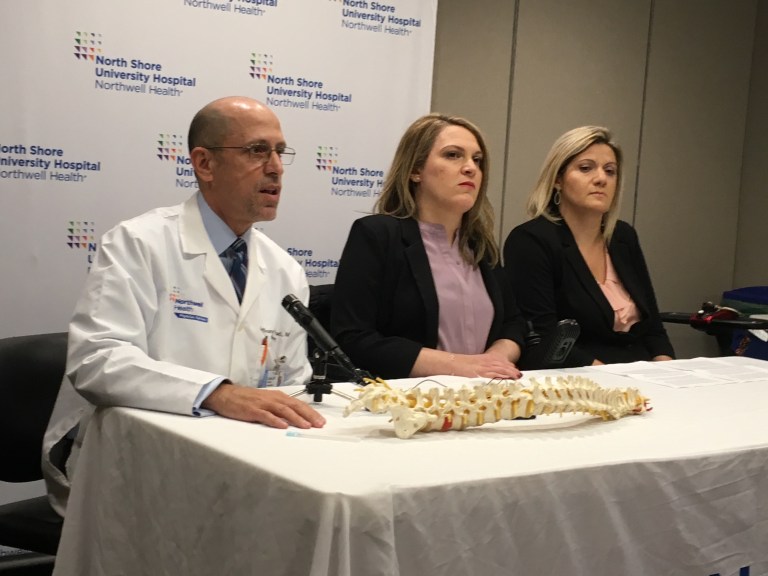
For most of their lives, Laura Chamadian and Lisa Panzica were resigned to living with spinal muscular atrophy, a genetic disease that inhibits their muscle movement and often left them fatigued.
That changed in July, when the New Hyde Park sisters became the first siblings in New York to be treated with Spinraza, a groundbreaking new drug that they said has changed their lives.
“I have been given a hope and a miracle, one that I never thought I would see in my lifetime,” Panzica, 40, said during a news conference last Thursday at North Shore University Hospital in Manhasset.
Spinal muscular atrophy, or SMA, stems from a genetic mutation that causes nerves to produce too little of the protein that allow for muscle movement, said Dr. Anthony Geraci, the director of neuromuscular medicine for Northwell Health.
Patients are usually diagnosed young and go through their lives having trouble moving, swallowing and breathing, Geraci said. SMA affects one in every 6,000 births in the U.S. and gets progressively worse with age, he said.
But Spinraza, which the federal Food and Drug Administration approved less than a year ago, uses a special molecule to help those nerve cells in the spinal cord produce more protein, giving patients more control over their movements, Geraci said.
“This has really been a significant advance,” Geraci said. “It’s one of the first uses of this type of molecule in clinical medicine.”
Panzica and Chamadian said the disease poses obstacles every day. As a student at Great Neck South High School, Chamadian, 38, had to leave class five minutes early to get to her next class on time, she said. She also couldn’t pick up or physically play with any of her three children.
Panzica uses a wheelchair to get around, while Chamadian uses a scooter. But everyday tasks have become easier since they started receiving Spinraza injections in May, they said. For example, Panzica, an ambulatory health information manager for Northwell Health, can now open the door to her office on her own, she said.
“I feel I’m a completely different person at this point,” Panzica, a Great Neck North High School graduate, said. “I have people telling me that every day.”
Spinraza, developed over more than two decades by the Cambridge, Mass.-based company BioGen, is delivered by injecting the drug into the sac of fluid surrounding the spinal cord using a needle about four inches long, Geraci said.
The sisters received four initial doses of Spinraza in two months starting in July and will now get one dose every four months. Each injection costs about $125,000, Geraci said; Panzica’s and Chamadian’s treatments are covered by their insurance.
The pair have gotten all their injections together, which helped Chamadian overcome her fear of needles, she said. Her children are “super happy” with the improvement they’ve seen in her, she said.
“Instead of talking about normal sister things, we talk about this — ‘Did your arms move today?’ ” said Chamadian, who works at home for an answering service.
Spinraza has been proven to work in infants with SMA, but doctors are now collecting data on its use in adolescents and adults, Geraci said. Geraci is currently treating six patients with the drug and evaluating 13 others, he said.
While it’s not a cure, Geraci said Spinraza is a “miracle drug” because it has created a “profound change” in the outlook for SMA patients.
When Geraci first started his medical studies in 1991, he said, doctors in his field were taught to help SMA patients pick out wheelchairs and ultimately plan for their deaths.
The way Spinraza treats the disease could be used to help patients with myriad other diseases, Geraci said.
“It’s actually very exciting on how many diseases we could apply this to,” he said. “You name the genetic disease, it’s something we could look at and potentially be a candidate.”






